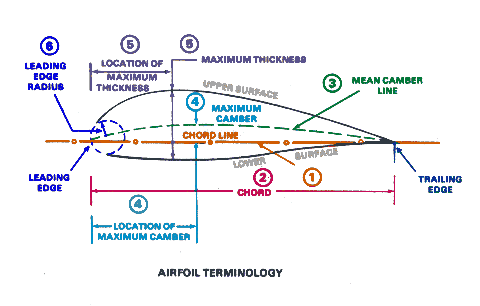 Sustenation (A Wing or Rotor Blade)
Sustenation (A Wing or Rotor Blade)
 For Stability (As a Fin)
For Stability (As a Fin)
 For Control (A Flight Surface, such as a Rudder)
For Control (A Flight Surface, such as a Rudder)
 For Thrust (A Propeller or Rotor Blade)
For Thrust (A Propeller or Rotor Blade)
 Sustenation (A Wing or Rotor Blade)
Sustenation (A Wing or Rotor Blade)
 For Stability (As a Fin)
For Stability (As a Fin)
 For Control (A Flight Surface, such as a Rudder)
For Control (A Flight Surface, such as a Rudder)
 For Thrust (A Propeller or Rotor Blade)
For Thrust (A Propeller or Rotor Blade)Some airfoils combine some of these functions.
A helicopter flies for the same basic reason that any conventional aircraft flies, because aerodynamic forces necessary to keep it aloft are produced when air passes about the rotor blades. The rotor blade, or airfoil, is the structure that makes flight possible. Its shape produces lift when it passes through the air. Helicopter blades have airfoil sections designed for a specific set of flight characteristics. Usually the designer must compromise to obtain an airfoil section that has the best flight characteristics for the mission the aircraft will perform.
Airfoil sections are of two basic types, symmetrical and nonsymmetrical.
Symmetrical airfoils have identical upper and lower surfaces. They are suited to rotary-wing applications because they have almost no center of pressure travel. Travel remains relatively constant under varying angles of attack, affording the best lift-drag ratios for the full range of velocities from rotor blade root to tip. However, the symmetrical airfoil produces less lift than a nonsymmetrical airfoil and also has relatively undesirable stall characteristics. The helicopter blade (airfoil) must adapt to a wide range of airspeeds and angles of attack during each revolution of the rotor. The symmetrical airfoil delivers acceptable performance under those alternating conditions. Other benefits are lower cost and ease of construction as comparedto the nonsymmetrical airfoil.
Nonsymmetrical (cambered) airfoils may have a wide variety of upper and lower surface designs. The advantages of the nonsymmetrical airfoil are increased lift-drag ratios and more desirable stall characteristics. Nonsymmetrical airfoils were not used in earlier helicopters because the center of pressure location moved too much when angle of attack was changed. When center of pressure moves, a twisting force is exerted on the rotor blades. Rotor system components had to be designed that would withstand the twisting force. Recent design processes and new materials used to manufacture rotor systems have partially overcome the problems associated with use of nonsymmetrical airfoils.

 The Chord Line (1) is a straight line connecting the leading and trailing edges of the airfoil.
The Chord Line (1) is a straight line connecting the leading and trailing edges of the airfoil.
 The Chord (2) is the length of the chordline from leading edge to trailing edge and is the characteristic longitudinal dimension of an airfoil.
The Chord (2) is the length of the chordline from leading edge to trailing edge and is the characteristic longitudinal dimension of an airfoil.
 The Mean Camber Line (3) is a line drawn halfway between the upper and lower surfaces. The chord line connects the ends of the mean camber line.
The Mean Camber Line (3) is a line drawn halfway between the upper and lower surfaces. The chord line connects the ends of the mean camber line.
 The shape of the mean camber is important in determining the aerodynamic characteristics of an airfoil section. Maximum Camber (4) (displacement of the mean camber line from the chord line) and where it is located (expressed as fractions or percentages of the basic chord) help to define the shape of the mean camber line.
The shape of the mean camber is important in determining the aerodynamic characteristics of an airfoil section. Maximum Camber (4) (displacement of the mean camber line from the chord line) and where it is located (expressed as fractions or percentages of the basic chord) help to define the shape of the mean camber line.
 The Maximum Thickness (5) of an airfoil andwhere it is located (expressed as a percentage of the chord) help define the airfoil shape,and hence its performance.
The Maximum Thickness (5) of an airfoil andwhere it is located (expressed as a percentage of the chord) help define the airfoil shape,and hence its performance.
 The Leading Edge Radius (6) of the airfoil is the radius of curvature given the leading edge shape.
The Leading Edge Radius (6) of the airfoil is the radius of curvature given the leading edge shape.
The airfoil shown in the graphic is a Positive Cambered Airfoil because the mean camber line is located above the chord line. The term "Camber" refers to the curvature of an airfoil ot its surfaces. The mean camber of an airfoil may be considered as the curvature of the median line (mean camber line) of the airfoil.
 Return to Dynamic Aerodynamics!
Return to Dynamic Aerodynamics!
 Return to Dynamic Flight
Return to Dynamic Flight
Copyright ©1999-2017 Dynamic Flight, Inc. All rights reserved.
Page Last Updated on: Nov-06-2017